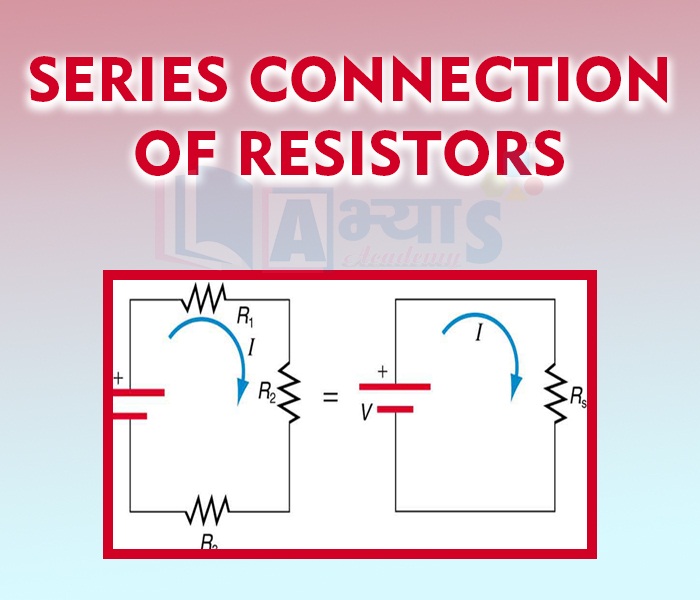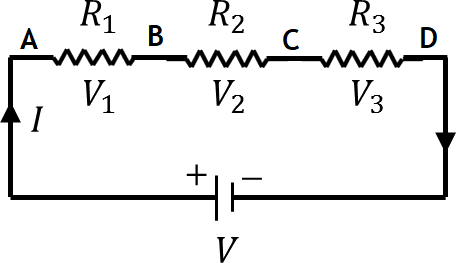Series Connection of Resistors


Series Connection of Resistors
Combination of Resistance:
In many applications to get a required value of resistance two or more resistances are combined. Two or more resistance can be combined in more than one way.
1. Series Combination
2. Parallel Combination
If, in an electrical circuit, two or more resistances connected between two points are replaced by a single resistance such that there is no change in the current of the circuit and in the potential difference between those two points, then the single resistance is called the 'equivalent resistance. When the resistance of a circuit is to be increased, they are combined in series and when heavy current is to be passed they are combined in parallel so as to decrease the total resistance.
Series Combination of Resistance:
In this combination, the resistances are joined end to end. Thus the second end of each resistance is joined to the first end of the next resistance, and so on. The first end of the first resistance and the second end of the last resistance are connected to the cell. In this combination, the same current flows in all the resistances but the potential differences between their ends are different according to their resistances.
In this combination more than one resistance is connected one after the other as shown. In this type of circuit:

1. Equal current flows through each resistance.
2. Total voltage drop across the combination is equal to the sum of voltage drop across each resistance.
3. Voltage drop each resistance can be calculated using Ohm’s Law and is proportional to the value of resistance.
4. Equivalent resistance is thus greater than resistance of any resistor in the circuit.. This is also known as maximum effective resistance
In the circuit given we have three resistance R1, R2 and R3 are connected in series and V1, V2 and V3 are the potential drop across each resistance respectively. If I is the current flowing through the circuit when a cell with potential difference V is applied across them
.......(1)
.......(2)
.......(3)
Now, let us assume a resistance is the equivalent resistance which will have the same potential difference as the combination.
.......(4)
Equivalent resistance can be calculated by using the fact that total potential drop in the circuit is equal to the sum of potential drop across each resistance
.......(5)
Substituting the value from Equations 1, 2, 3, 4 in 5 we get
The sum of individual potential drop across the resistors connected in series is equal to the total potential difference across the series can be derived as follows
Potential difference across point A and B
Potential difference across point B and C ,
Potential difference across Point C and D
On adding the potentials across
i.e. equal to the potential difference between points A and D = V
Disadvantages of Series Combination:
(i) In series combination, if any of the components fail to work, the circuit will break and then none of the components will work.
(ii) It is not possible to connect a bulb and a heater in series because they need different values of current to operate properly. Hence, to overcome this problem we do not use series circuit.
Illustration: Five resistance are connected as shown in the figure below. Calculate current through the circuit, also calculate the potential drop across resistance R5

Solution: In the figure we are given five resistances which are connected in series. To calculate current in the circuit we have to calculate the equivalent resistance.
The equivalent resistance is the sum of individual resistance
Potential Difference V = 9 V
Current can be calculated using Ohm's Law
V= IR
As we know in series combination same current flows through all resistance.So 0.1 A current flows through the resistance R5.
Hence potential drop across R5 can be calculated using Ohm's Law
The current through the circuit is 0.1.A and the potential drop across R5 1 V.
Three batteries are connected as shown in the figure. If each cell has an e.m.f. of 3 V. The the total emf in the circuit is ________V.
| |||
| Right Option : B | |||
| View Explanation | |||
Three resistance of 3 ohm, 1 ohm and 2 ohm are connected in series.The effective resistance will be | |||
| Right Option : D | |||
| View Explanation | |||
Three bulbs each of resistance of 3 ohm are connected in series are connected to two fans of resistance 5 ohms each.The effective resistance will be | |||
| Right Option : D | |||
| View Explanation | |||
Students / Parents Reviews [10]
Being a parent, I saw my daughter improvement in her studies by seeing a good result in all day to day compititive exam TMO, NSO, IEO etc and as well as studies. I have got a fruitful result from my daughter.

Prisha Gupta
8thMy experience with Abhyas academy is very good. I did not think that my every subject coming here will be so strong. The main thing is that the online tests had made me learn here more things.

Hiya Gupta
8thIt has a great methodology. Students here can get analysis to their test quickly.We can learn easily through PPTs and the testing methods are good. We know that where we have to practice

Barkha Arora
10thAbout Abhyas metholodology the teachers are very nice and hardworking toward students.The Centre Head Mrs Anu Sethi is also a brilliant teacher.Abhyas has taught me how to overcome problems and has always taken my doubts and suppoeted me.

Shreya Shrivastava
8thMy experience was very good with Abhyas academy. I am studying here from 6th class and I am satisfied by its results in my life. I improved a lot here ahead of school syllabus.

Ayan Ghosh
8thAbhyas Methodology is very good. It is based on according to student and each child manages accordingly to its properly. Methodology has improved the abilities of students to shine them in future.

Manish Kumar
10thA marvelous experience with Abhyas. I am glad to share that my ward has achieved more than enough at the Ambala ABHYAS centre. Years have passed on and more and more he has gained. May the centre flourish and develop day by day by the grace of God.

Archit Segal
7thIt was a good experience with Abhyas Academy. I even faced problems in starting but slowly and steadily overcomed. Especially reasoning classes helped me a lot.

Cheshta
10thAbhyas is a complete education Institute. Here extreme care is taken by teacher with the help of regular exam. Extra classes also conducted by the institute, if the student is weak.

Om Umang
10thMy experience with Abhyas is very good. I have learnt many things here like vedic maths and reasoning also. Teachers here first take our doubts and then there are assignments to verify our weak points.

